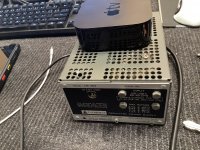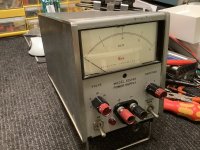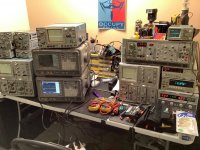HAHAHAH... I dont feel so bad then !...The DIYers curse to buy/build way more than just 1 good linear PSU and then end up with many very good PSUs without any use. Familiar. I made at least 12 of them during Covid/lockdown.
Not to mention how many caps and parts you change out on each one as you go and try things ! I have boxes of discarded caps and parts...
OMG.. Yes I feel at home here now... hehehehe...
I find all sorts of uses tho for them..
For example... You guys must also do this... Put a linear on EVERYTHING... Router, cable modem, hahahaha..
BUT anyone reading this, be aware, the Lambdas are wonderful, BUT, you gotta recap them. Caps are all toast.
Attachments
Mine are all repainted, powder coated and recapped or simply newly built own designs. Apart from that my mental health seems OK.
Yes the ethernet switch has one, audio player has one etc. Seen from that point of view everything can use a linear PSU.
Yes the ethernet switch has one, audio player has one etc. Seen from that point of view everything can use a linear PSU.
I can get stunning performance from a LAmbda A or B series supply...
These plots are while hooked up to a device. Top lot is std supply.. Bottom plot is with remote sensing and a restored and modded Lambda LS A12
Before

After

These plots are while hooked up to a device. Top lot is std supply.. Bottom plot is with remote sensing and a restored and modded Lambda LS A12
Before
After
OMG... F***** AWESOME !!! Thats hard core wonderful.. Im not sure of my mental health tho, I get into fixing one up and kinda loose my mind.. I want that last uV of noise gone.. hahaha...Mine are all repainted, powder coated and recapped or simply newly built own designs. Apart from that my mental health seems OK.
The B series lambdas are discrete. No chips. 🙂 I also have a really fun variable HP before it was HP its all based on mil grade germanium.. And still works perfectly - after recap..Must be based on the king of the hill: LM723.
Not many Lambda here (unfortunately) in 230V territory but I know them. Power One and Astron can be found. Another very good old brand is Delta (the dutch Delta).
Finding the necessary good quality low ESR long life 10,000 µF 16 or 25V snap in caps today is however frustrating.
Finding the necessary good quality low ESR long life 10,000 µF 16 or 25V snap in caps today is however frustrating.
Last edited:
Oh yea, Delta is great..No Lambda here (unfortunately) in 230V territory but I know them. Power One and Astron can be found. Another very good old brand is Delta (the dutch Delta).
Finding the necessary 10,000 µF 16 or 25V snap in caps today is however frustrating.
I think the Lambdas can be set for 220 with taps,,, hmm,, maybe not. I dont remember. I will look...
You will hate me, when doing "restore" I don't make them look vintage. I use modern caps and go for performance and looks be damned. I KNOW,, thats horrible,, but I am after performance and use them just for myself, I don't restore for others. I do it for my own gear only..
No that is not horrible at all, it is getting maximum performance out of old gear that already outperforms the modern equivalent big time. They need restoring anyway so why not make the best of it? If not done they would gather dust somewhere or (horror) end up in recycling reincarnating as a part in a Tesla. Brrrrrr.
Last edited:
You should play with a Tek 7904 I have insanely modded and restored.. I really dont like digital scopes... Using ANALOG gear to do ANALOG engineering is the ONLY way it should be done.. None of the Tek MSO sampling.. Bah... hahahaha..No that is not horrible at all, it is getting maximum performance out of old gear.
Of course we have wandered way off topic, hahaha.. BUT I guess its OK as your kinda in charge, hahaha..
Attachments
Maybe because improving already known good gear has better time/quality ratio compared to the subject.
BTW I am not in charge of anything. Story of my life 😀
BTW I am not in charge of anything. Story of my life 😀
Here shop keepers tell me TL431 is a transistor....
And local temperature controllers use one junction of BC547 as the cold junction, most are 741 based.
Designed as a comparator, thermocouple is hot junction.
Digital display, pot or thumb wheel to set.
New ones are all digital, with many more functions like ramp and so on.
And local temperature controllers use one junction of BC547 as the cold junction, most are 741 based.
Designed as a comparator, thermocouple is hot junction.
Digital display, pot or thumb wheel to set.
New ones are all digital, with many more functions like ramp and so on.
which is working fantastic for a application I have,
So, why is it fantastic then? Just scratching my head ;-)but, its abnormally noisy and a bit unstable. [] Its weirdly unstable. Certain loads cause a oscillation. No load has it too. It has a 4mV pk-pk very random looking noise. Its VERY picky on which mfgr of TL431 and even grade.
Jan
Well I have spent 6 weeks going thru a lot of linears. I would prefer to not discuss what its for. I know, thats a party killer right there... There are 2 reviews in progress and I will talk more about things after those are published 🙂 This is like 3-4 weeks yet 🙁 Discussing that would just derail this discussion anyway..So, why is it fantastic then? Just scratching my head ;-)
Jan
So lets just say I have tried nearly every available linear and some switchers and done so much AB its just insane..
The device has 4 buck boost regulators in it feeding various chips. I cannot bypass those and can't do any mods because of space requirements. So my omly way to improve the quality of the supply to the chips is to try and manipulate the PWM regulators and make them happier. These things are HORRID and NASTY and SPEW harmonic crap all over the place which soaks into everything around them. Its REAL tricky to hook caps to the line side of them and quash out noise so they spew less crap all over the stuff around them. I spent 3 months, daily, working that out. Eventually it was time to then focus on a linear. So I spent a month, daily full time, playing with typologies and I think about every known regulation scheme. I eventually landed on using discrete parts rather then any chips. I even eventually discovered that they don't make these discrete parts like they used to and ended up buying Lambdas and reworking them. I needed sensing so I can bring the regulation point right onto the board of the device I was powering. No way to reach uV of noise, -100db and +- 0.00001Vdc drift without remote sensing.
I really cant sell Lambdas tho. But I had a reference supply to work against so I could AB different supplies and judge the performance of the linears using the device.
Then a LONG list of linears and stupid amounts of AB ensued. Everything pretty much sucked in performance, just some less then others. But then I hooked up the supply I mentioned here and this immd exceeded the Lambda. By a bunch.. WTF...
Measuring it was horrifying. EVERY spec i measured was terrible. YET the device it was powering was just clearly better.
I ripped into it and ran into this freaky circuit. I dont know of any other device, ever, that has used this. I cant find anything online close to it. I cant even make much sense of it.
So I have come here to see if anyone here is a TL431AC ( fairchild / On ) expert and might be able to explain it..
The weird divider for example. 10k > 50k pot > 10k ... Thats a LOT higher then any values i have seen for this part. WTF is that cap for ? Why a LM317 ? The TL431 could drive a transistor for this current. That is a interesting transistor to choose, why use one like that ?
I did tonight do a mod that made for better performance from the device it hooks to. i used a really good 0.68uF poly cap VS the 0.1uf.. BUt I am not really sure what changed, so, just a stab in the dark..
I want to go reverify that this cap really connects to the pot. It seems so hard to believe I want to triple check.
I did something reckless to gain remote sensing. I am afraid to even post what i did. hahahahaha.. It, uhhh, sorta works tho somehow..
More tomorrow.
Last edited:
In some tube circles designing is done by baking randomly chosen parts to eachother and then listen. Maybe these guys are right after all and is calculation with part parameters and annoying items like voltage and current a social construct too.
hahaha..social construct
Alchemy.
Yea maybe. I donno, I think someone with a SPICE tool crafted something odd. You know a bit of wideband random noise injected into the power supply of a lot of different things might produce results that might be favorable, if inaccurate 🙂 The human perceptual model is incomplete and highly complex 🙂
Into analog gear a very slight background hiss might be kinda tubey. On things with PWM regulators that same hiss dithers the spectra of the radiated spikes being sprayed into other parts. What that could do is anyones guess.
Its curious. Maybe I will go find a EE forum and ask some SPICE modeling guys to plug this in and see what comes out. i need to triple verify that cap on the TL431. I verified one side goes to gnd, but I will ohm out the other side.
I am pretty sure I don't know what I am doing with the TL431, well I did sorta until this circuit came along.. So that high resistance on the ADJ pin 10k > 50k > 10k means the TL431 has gain ? And is operating much closer to open loop. So would this make it more sensitive to cancellation signals coming in ? or less sensitive ? So a cap on the cath or on the adj to ground would low pass filter and limit bandwidth right ? Which if this has gain might be a good thing. The LM317 has much less bandwidth so limiting the bandwidth of the TL431 would make sense.
So really the TL431 is like a little op-amp with gain in this case with one input tied to the internal reference.
The TL431 does not have enough drive to handle that output transistor I don't think. That output transistor would offer a nice low output impeadance. But why use a LM317 to drive it. Unless maybe the LM317 offers not only the means to drive the transistor but a second stage of regulation all in one package.
Hmmm... This circuit is making some sense maybe. Well, I am just smart enough to be really stupid tho..
There was a really smart guy on the Facebook vintage Tektronix forum I ran into while modding the 7904 who literally wrote some books on power supply design.. I am going to go send him this schematic and ask if he has any idea what is going on here.
So really the TL431 is like a little op-amp with gain in this case with one input tied to the internal reference.
The TL431 does not have enough drive to handle that output transistor I don't think. That output transistor would offer a nice low output impeadance. But why use a LM317 to drive it. Unless maybe the LM317 offers not only the means to drive the transistor but a second stage of regulation all in one package.
Hmmm... This circuit is making some sense maybe. Well, I am just smart enough to be really stupid tho..
There was a really smart guy on the Facebook vintage Tektronix forum I ran into while modding the 7904 who literally wrote some books on power supply design.. I am going to go send him this schematic and ask if he has any idea what is going on here.
Last edited:
100nf in parallel to TL431 could cause it to go unstable, look at the 431 datasheet on stability.
- Home
- Amplifiers
- Power Supplies
- TL431 + LM317 + PNP = linear question



